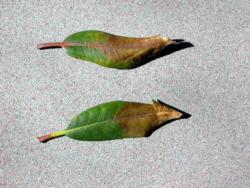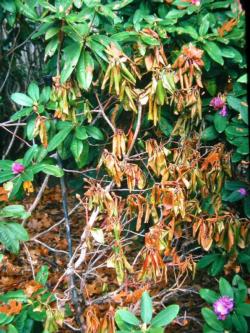Unused stories
Pest of the Month - Root Rot

Many ornamental trees and shrubs are susceptible to Phytophthora root rot and can develop root and crown rot, particularly if the soil around the base of the plant remains wet for long periods of time. Typical symptoms of a root disease are apparent on infected plants. The leaves will appear droughtstressed and may die quickly as the weather warms in late spring or early summer. Trees that are especially susceptible include oak and dogwood.

Leaves will appear drought stressed, sometimes turning dull green, yellow, red, or purple as they wilt. Infected trees may survive a few years before the disease kills the whole plant. The bark around the soil-line may appear darkened. Cutting away some bark should reveal red-brown discoloration in the wood underneath it. Disease symptoms are distinguishable from Armillaria root rot because mycelial mats do not develop in tissues infected with Phytophthora root rot.
Life Cycle
Root rot-causing Phytophthora species can survive in the soil for years, as long as moist conditions persist. It can spread through splashing rain, irrigation water, and runoff water. Disease fungi can spread through contaminated soil and garden equipment as well. Rot is more likely to spread in early spring and late fall during cool, rainy weather. But symptoms are more likely during stress periods of low rainfall. Flooded and saturated soil conditions for 6–8 hours are especially conducive to the spread of root rots. Wounds are not required for infection.
Integrated Pest Management Strategies
- Improve water drainage. Prior to planting, make amendments to the soil composition to help manage drainage away from tree roots. Don’t allow water to pool around the collar or root system. Core aerate to improve drainage and lessen compaction.
- Raise the planting site to avoid poor drainage and prevent pools of standing water from forming around valuable ornamentals. Plant on mounds of soil. Never plant trees deeper than they were planted at the nursery.
- Separate plants, shrubs, and trees according to their irrigation needs, and avoid overwatering.
- Remove soil. If soil has been piled up over the crown, remove it carefully to expose root flare. This is where fungal infection is likely to occur.
- Plant resistant or less susceptible varieties. Consider replanting with tolerant plants after Phytophthora root rot has been diagnosed. Trees that are tolerant to Phytophthora root rot include white cedar and American arborvitae.
All of the recommended IPM strategies are strictly organic approaches.
Article courtesy of the Missouri Botanical Garden
